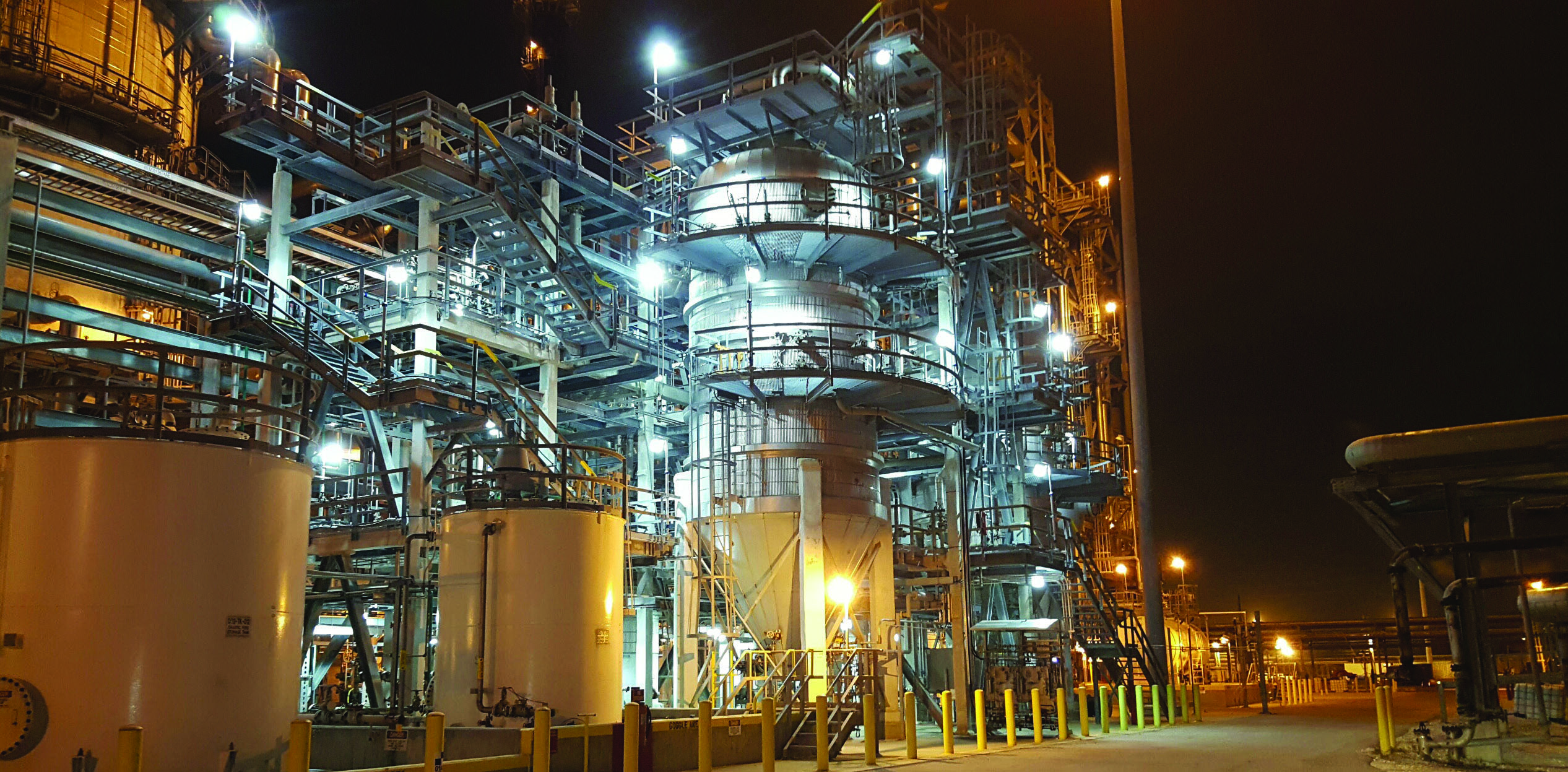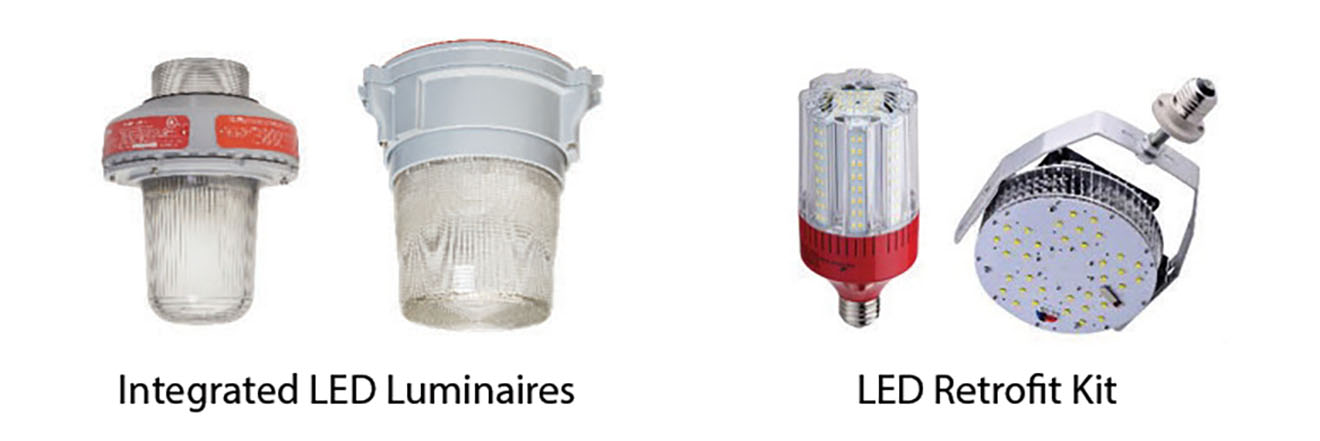
Emerson has released a new whitepaper exploring the potential dangers of installing LED retrofit kits in industrial areas classified as “Hazardous” by international electrical code standards. Based on in-depth research and interviews with thought leaders, the whitepaper establishes best practices for Emerson customers as they convert their facilities from energy inefficient fluorescent and high intensity discharge (HID) legacy lighting to modern solid state or Light Emitting Diode (LED) technology.
The whitepaper “Dangers and Pitfalls of Installing LED Retrofit Lamps in Hazardous Locations” helps bridge a critical knowledge gap that continues to challenge industry regarding the safety, reliability and performance capabilities of LED retrofit kits versus integral LED luminaires. In contrast to replacing an existing fluorescent or HID light fixture with a fully contained LED luminaire, an LED retrofit kit modifies the legacy fixture to LED technology. In most cases the legacy lamp is replaced with an LED light subassembly, commonly called a “corn cob light,” that directly screws into the legacy lamp socket.
Pressured by tight budgets, a plant manager tasked with modernization of the lighting within their facility’s hazardous locations may be tempted to install low-cost LED retrofit kits, rather than integral LED luminaire assemblies. The following key themes against this approach emerged and are detailed in the whitepaper:
- In a closely monitored lab, hazardous location retrofit lamps failed to meet the manufacturer’s published lumen output claims when installed in Emerson’s Appleton™ Mercmaster III™ HID luminaires, nor did they meet current Illuminating Engineering Society and American Petroleum Institute Recommended Practice for Electrical Installations (RP540) standards for safe lighting. When exposed to plant-like conditions, the kits underperformed integral LED luminaires by as much as 61 percent, presenting a serious safety risk to workers.
- Traditional HID luminaires were not designed with LED use in mind, and therefore do not employ the same heat-sink methodologies. Instead, retrofit kits rely on “active cooling and dynamic temperature control” that employ internal fans for cooling and cutback on electrical current and diminish light output as ambient temperatures rise. Emerson’s integral LED luminaires are designed with custom heat sinks, engineered to optimize thermal performance and pull heat away from sensitive electronic components to help achieve 50,000+ hours of service life.
- LED retrofit lamps produce an omni-directional spread similar to traditional lamps. The unfocused, 360° distribution loses over 35% of the light produced above the 90° horizontal plane, resulting in poor levels of illumination, which limit vision and lead to eye fatigue and lowered productivity. An integral LED luminaire with well-designed optics will achieve balanced illumination with uniform brightness to create a working space that is optically larger, safer and more productive.
- Electrical surges and transients are common in industrial environments and have historically been one of the largest contributors to premature LED luminaire failures. IEEE/ANSI C136.2-2018 was updated to address these failures and provides recommendations and test procedures for a minimum of 6kV/3kA surge protection for outdoor LED luminaires. Due to size constraints in retrofit lamps, surge protection is often lacking, meaning that reliability is severely compromised.
 “Our findings illustrate that LED retrofit lamps are not equal to integral LED luminaires on the basis of current code standards, lighting quality, lumen output, surge protection, overall reliability or total cost of ownership,” said Ellen Helm, Director of Product Marketing, Emerson Automation Solutions. “We hope this whitepaper will spark conversation, learning, and the exchange of ideas about the future of LED lighting that is so necessary for its continued safe use.”
“Our findings illustrate that LED retrofit lamps are not equal to integral LED luminaires on the basis of current code standards, lighting quality, lumen output, surge protection, overall reliability or total cost of ownership,” said Ellen Helm, Director of Product Marketing, Emerson Automation Solutions. “We hope this whitepaper will spark conversation, learning, and the exchange of ideas about the future of LED lighting that is so necessary for its continued safe use.”
In the interest of safety, Emerson does not approve or authorize installation of LED conversion or retrofit products to its legacy lighting fixtures, as they were not designed, qualified, or agency certified for use with LED lighting technology, nor does Emerson assume responsibility or liability for any such modified Appleton or O-Z/Gedney light fixtures.
About Emerson
Emerson (NYSE: EMR), headquartered in St. Louis, Missouri (USA), is a global technology and engineering company providing innovative solutions for customers in industrial, commercial, and residential markets. Our Emerson Automation Solutions business helps process, hybrid, and discrete manufacturers maximize production, protect personnel and the environment while optimizing their energy and operating costs. Our Emerson Commercial & Residential Solutions business helps ensure human comfort and health, protect food quality and safety, advance energy efficiency, and create sustainable infrastructure.
Emerson Headquarters | United States
9377 W. Higgins Road
Rosemont, IL 60018 USA
P: (800) 621-1506
Contact
Maya Jordan










































